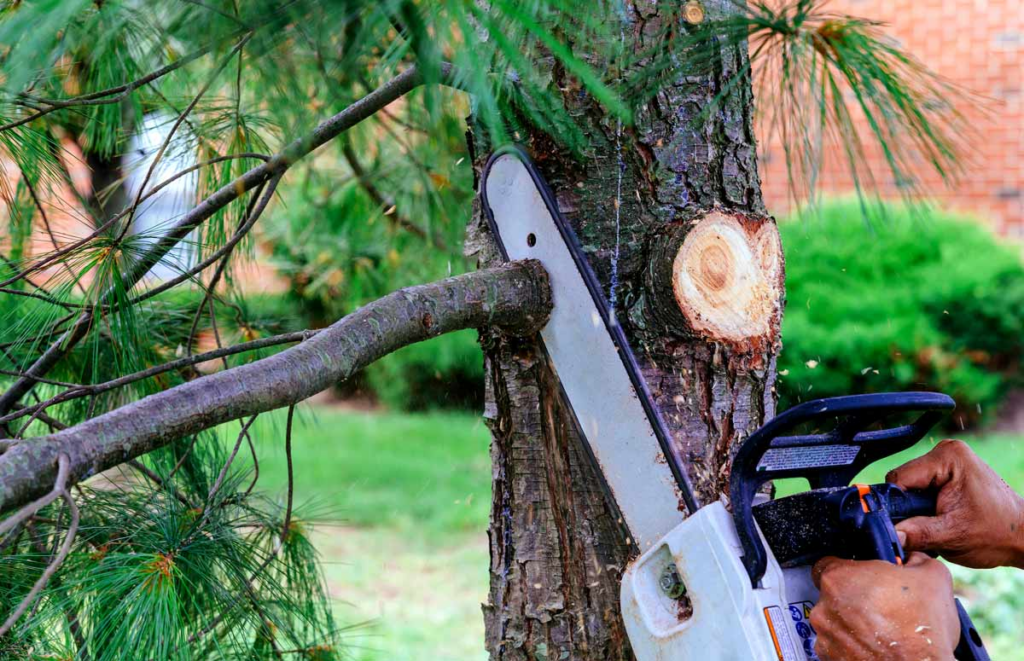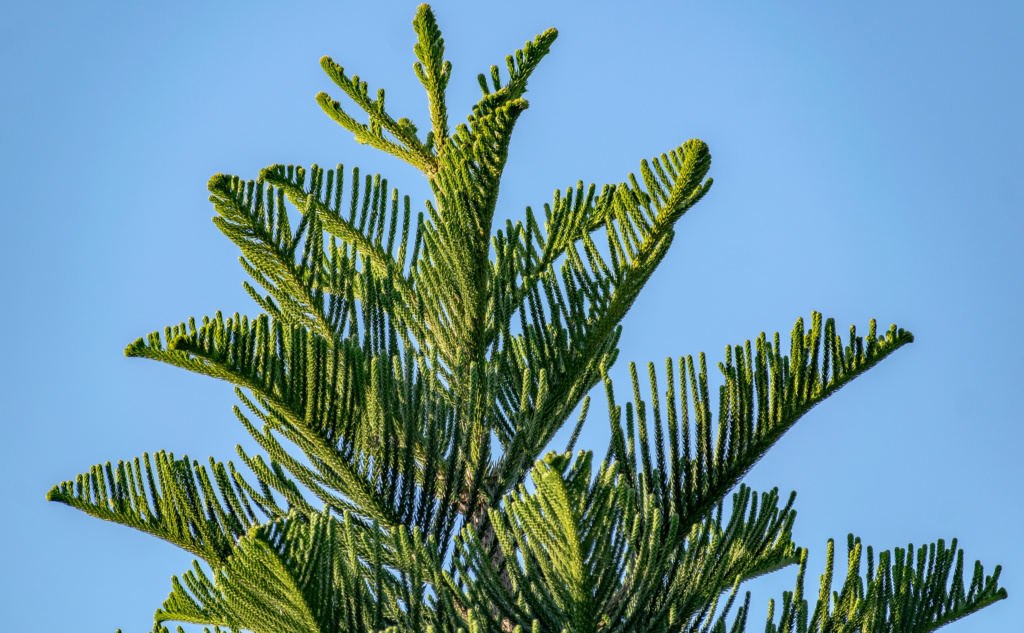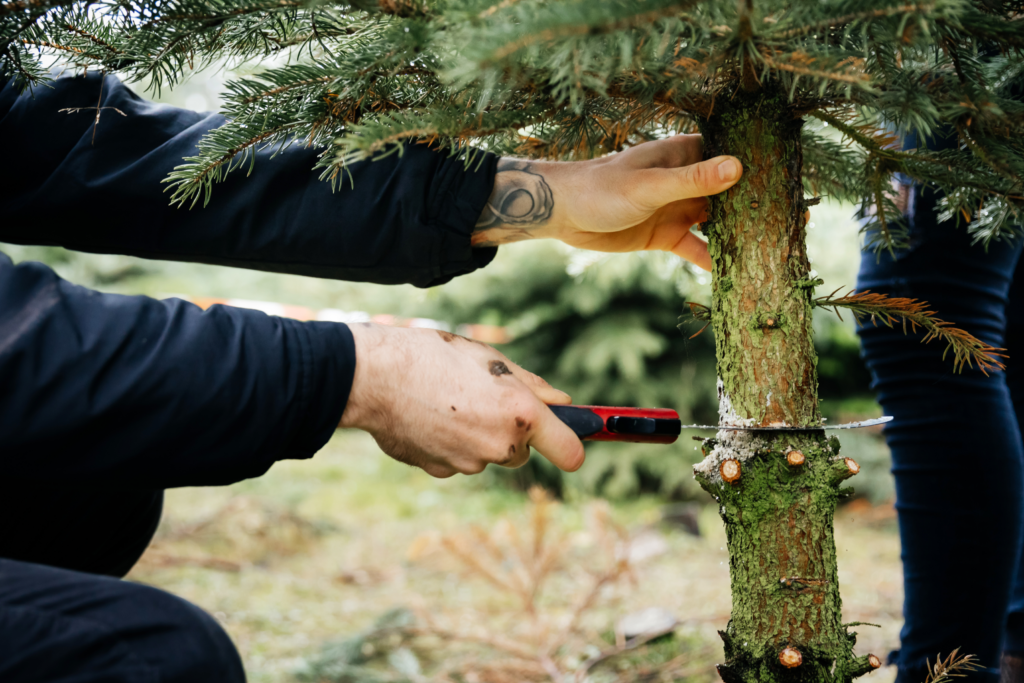Maintaining the health and beauty of trees is a crucial aspect of landscaping for homeowners. Among the diverse array of trees that grace our residential landscapes, pine trees stand out with their elegant form and distinctive foliage.
However, like any other tree, pines require regular maintenance to thrive and remain visually appealing. One essential practice is tree trimming, which not only enhances the tree’s aesthetic appeal but also contributes to its overall health and longevity.
With their immense size and density, many homeowners wonder how to trim a pine tree. In this blog, we will explore the art of pruning and provide five easy tips to achieve professional-looking results.
Whether you are a seasoned gardener or just starting out, these practical guidelines will empower you to confidently trim your majestic pine trees and enjoy the many benefits they bring to your outdoor space.
So, let’s delve into the world of pine tree trimming and discover how you can elevate your landscaping skills to new heights!
Understanding Pine Trees
Pine trees are a common sight in residential landscapes. These trees encompass a wide range of species, each possessing its own distinct qualities and visual appeal. From the towering Eastern White Pine to the compact and hardy Scots Pine, homeowners can choose from an assortment of trees that suit their preferences and climate conditions.
Characterized by their evergreen needles, lush foliage, and iconic cone-shaped structure, pine trees have specific growth patterns that set them apart from other tree species.
Understanding these growth patterns is crucial for effective and precise trimming. These trees generally exhibit a central leader, which is the main trunk that extends upward, while lateral branches develop in a tiered fashion along the length of the tree.
There are several reasons why pine trees may require trimming. One primary motive is to promote the tree’s health and vitality. Trimming helps to remove dead, diseased, or damaged branches, which can impede the tree’s overall well-being and pose a risk of falling.
Additionally, trimming can enhance the tree’s aesthetics, ensuring a neat and well-maintained appearance and greener foliage that complements the surrounding landscape. It also allows for better airflow and sunlight penetration, reducing the risk of fungal diseases, brown needles, and promoting vigorous growth.
Safety Precautions

When it comes to trimming trees, including pine trees, safety should always be the top priority. Working with trees involves inherent risks, and taking appropriate safety precautions is crucial to ensure a smooth and accident-free trimming process.
Importance of Safety When Trimming Trees
Safety is paramount when undertaking tree trimming activities. The process involves working at heights, handling sharp tools, and dealing with potential hazards. By prioritizing safety, homeowners can protect themselves from injuries and create a secure environment for the task at hand. Whether you are an experienced gardener or a novice, always approach tree trimming with caution and follow safety guidelines.
Tips for Staying Safe During the Trimming Process
Check for Power Lines
Before starting any trimming work, carefully inspect the area for overhead power lines. Keep a safe distance from them to prevent accidents or electrical hazards. If power lines are present and require attention, it is strongly advised to contact a professional tree trimming service.
Use Proper Ladder Techniques
If using a ladder for reaching higher branches, ensure it is in good condition and placed on stable ground. Use the “Three-Point Rule” when ascending the ladder: maintain three points of contact at all times (e.g., two feet and one hand or two hands and one foot). Never overreach while on the ladder, as it can lead to loss of balance and potential falls.
Be Cautious of Potential Hazards
Stay vigilant of potential hazards such as falling branches and unstable footing. Always assess the stability of the ground before climbing a tree or using equipment. Avoid working in adverse weather conditions, as strong winds or wet surfaces can increase the risk of accidents. It’s crucial to wear appropriate safety gear, including gloves, safety glasses, and sturdy footwear, to protect against potential injuries.
Best Time to Trim Pine Trees

Timing is crucial when it comes to trimming pine trees, as it can significantly impact their growth and overall health. Understanding the optimal time for trimming ensures that you maximize the benefits of pruning while minimizing potential stress to the tree and maybe even saving yourself time with less maintenance in the future. Let’s explore the general guidelines for the ideal time to trim these trees, the difference between dormant and active growth periods, and the considerations specific to different pine tree species.
General Guidelines for the Ideal Time to Trim Pine Trees:
The best time to start pruning pine trees is during their dormant season or late winter/early spring. This period is advantageous because the tree is not actively growing and is less vulnerable to stress. Trimming during this time promotes healthy regrowth and allows the tree to allocate its resources effectively. However, it’s important to note that if there are dead, diseased, or damaged branches that pose immediate risks, they should be removed regardless of the season.
Explanation of Dormant vs. Active Growth Periods and Their Impact on Trimming
During the dormant season, pine trees are in a period of rest and exhibit minimal growth. This makes it an ideal time to prune as it minimizes the impact on the tree’s energy reserves. In contrast, the active growth period occurs during spring and summer when these trees are actively producing new shoots, needles, and cones. Avoid trimming during this period as this can be more stressful for the tree, as it diverts energy from growth and may lead to potential infections or diseases. Therefore, it’s generally recommended to avoid heavy pruning during the active period.
Considerations for Specific Pine Tree Species and Their Preferred Trimming Seasons
Different pine tree species may have specific preferences for trimming seasons. Some species, like the Eastern White Pine, benefit from trimming in late winter or early spring. Others, such as the Ponderosa Pine, may tolerate light maintenance during the active growth period. It is essential to research the specific needs and growth patterns of the pine tree species in your landscape to determine the most suitable trimming season for optimal results.
By adhering to these guidelines and considering the specific preferences of your pine tree species, you can ensure that the trimming process is timed appropriately, providing the tree with the best opportunity for healthy growth and regrowth.
However, it’s important to note that if you are uncertain or have complex trimming requirements, consulting a professional arborist can provide expert guidance tailored to your specific tree’s needs.
Five Easy Tips for Trimming

Trimming trees can seem like a daunting task, but with the right knowledge and techniques, it can become a manageable and rewarding experience. And since it’s not as simple as seaching, “how to trim a pine tree,” here are a few basic steps to help homeowners achieve professional-looking results.
Tip 1: Assessing the Tree’s Health and Trimming Needs
Before starting any trimming, assess the overall health of the pine tree and identify specific branches that require attention. Look for signs of dead branches, disease, deadwood, or damage. By focusing on areas that need pruning, you can prioritize the tree’s health and ensure that your efforts are targeted and effective.
Tip 2: Pruning Techniques
When it comes time to prune a pine tree, it’s essential to understand the correct techniques. Start by making clean, angled cuts just outside the branch collar, which is the slightly swollen area where the branch meets the trunk or larger branch. Avoid leaving stubs or cutting too close to the trunk, as this can hinder the tree’s ability to heal properly.
Tip 3: Removing Lower Branches and Clearing Obstructions
Lower branches can obstruct paths, obstruct views, or interfere with other plants. Carefully identify branches that are low-hanging or pose obstacles and remove them to create a cleaner and more open space. However, be cautious not to remove too many lower branches, as they contribute to the tree’s stability and natural form.
Tip 4: Dealing with Overgrown or Misshapen Trees
If your pine tree has become overgrown or developed an uneven shape, it may require more extensive trimming. Gradually create thinner branches, focusing on those that cross or rub against each other. Maintain the tree’s natural shape while creating a more balanced and aesthetically pleasing silhouette.
Tip 5: Post-Trimming Care and Maintenance
After the trimming process, provide proper care and maintenance to support the tree’s recovery and ongoing health. This includes watering the tree adequately, especially during dry periods, and applying a layer of mulch around the base to retain moisture and suppress weed growth. Regularly monitor the tree for any signs of pests or diseases and take appropriate action if needed.
The Importance of Hiring Professional Tree Trimming Services

While do-it-yourself tree trimming can be tempting, there are distinct advantages to entrusting the task to professional tree trimming services. These experts possess the knowledge, experience, and specialized equipment necessary to ensure the health and beauty of your trees.
Benefits of Hiring Professionals for Tree Trimming
Professional pine trees experts offer several benefits that make them worth considering. They bring expertise, experience, and a deep understanding of tree health and maintenance. Their skills, knowledge, and other garden services contribute to the optimal trimming of your trees, promoting their vitality and longevity.
Moreover, professionals are well-equipped to handle the inherent risks associated with tree trimming, ensuring the safety of both your property and themselves.
Expertise and Experience in Assessing Tree Health and Identifying Trimming Needs
Professionals possess the expertise to assess the health of your trees accurately. They can identify signs of disease, stress, or structural issues that may not be immediately apparent to untrained eyes. This allows them to determine the specific trimming needs of each tree, providing targeted care that enhances their overall health and appearance. Additionally, they can offer new growth tips, safe and experienced hands, and specialized heavy machinery.
Proper Training in Pruning Techniques to Ensure Tree Health and Aesthetics
Professional tree trimmers undergo rigorous training in proper pruning techniques. They understand the intricacies of pruning trees, such as knowing where and how to make precise cuts that promote healthy growth and maintain the tree’s natural form. Their knowledge and experience prevent over-pruning or improper cuts that can harm the pine tree’s form or compromise its aesthetics. Additionally, they can accurately identify dying branches and diseased branches.
Specialized Equipment for Safe and Efficient Tree Trimming
Tree trimming professionals are equipped with specialized tools and equipment designed for safe and efficient trimming. They have access to industry-standard equipment such as pruning shears, loppers, pole saws, and safety gear. This ensures that the trimming process is carried out effectively, minimizing the risk of accidents or damage to the tree or surrounding property
Liability and Insurance Considerations When Undertaking Tree Trimming
Undertaking tree trimming on your own can carry potential liabilities. Accidental property damage, personal injuries, or damage to utility lines are risks that homeowners may face. Professional tree trimming services typically carry liability insurance, providing you with peace of mind knowing that any unforeseen incidents or damages will be covered.
By hiring professional tree trimming services, homeowners can rest assured that their beautiful evergreens will receive the best care and attention. With their expertise, experience, and specialized equipment, professionals can assess tree health, employ proper pruning techniques, and mitigate potential risks. Moreover, the added liability coverage offers protection against unforeseen circumstances. So, when it comes to trimming your trees, consider the value and advantages that professional services bring to the table.
Conclusion
At the beginning of this article, readers may have wondered how to trim a pine tree. But armed with the five easy tips outlined in this blog, homeowners can confidently prune and maintain the health and beauty of their trees. By assessing the tree’s health, employing proper pruning techniques, removing lower branches, addressing overgrowth, and providing post-trimming care, it’s easier to achieve professional-looking results.
However, it’s crucial to recognize the advantages that professional tree trimming services bring to homeowners. These experts possess the necessary expertise, experience, and specialized equipment to ensure the optimal health and aesthetics of trees. Their ability to assess tree health, employ proper pruning techniques, and mitigate risks makes their services invaluable. Additionally, the liability coverage they provide offers homeowners peace of mind during the trimming process.
Regular tree maintenance, including trimming, plays a vital role in the overall health and longevity of trees. By maintaining a well-trimmed pine tree, homeowners can enhance the visual appeal of their landscape and create a safe environment for their property. Furthermore, the satisfaction of witnessing a well-trimmed, healthy pine tree flourish brings a sense of accomplishment and connection to nature.

